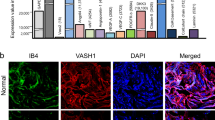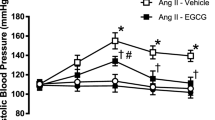Abstract
Diabetes Mellitus type 1 is a metabolic disease that predisposes to erectile dysfunction, partly owing to structural and molecular changes in the corpus cavernosum (CC) vessels. The aim of this study was to determine the effects of early treatment with the antioxidant epigallocatechin gallate (EGCG) in cavernous diabetes-induced vascular modifications. Diabetes was induced in two groups of young Wistar rats; one group was treated with EGCG for 10 weeks. A reduction in smooth muscle content was observed in the CC of diabetic rats, which was significantly attenuated with EGCG consumption. No differences were observed among groups, neither in the expression of VEGF assayed by western blotting nor in the immunofluorescent labeling of vascular endothelial growth factor (VEGF) and its receptors (VEGFR1 and VEGFR2). VEGFR2 was restricted to the endothelium, whereas VEGF and VEGFR1 co-localized in the smooth muscle layer. With regard to the Angiopoietin/Tie-2 system, no quantitative differences in Angiopoietin 1 were observed among the experimental groups. Ang1 localization was restricted to the smooth muscle layer, and receptor Tie2 and Angiopoietin 2 were both expressed in the endothelium. In brief, our results suggest that EGCG consumption prevented diabetes-induced loss of cavernous smooth muscle but does not affect vascular growth factor expression in young rats.
This is a preview of subscription content, access via your institution
Access options
Subscribe to this journal
Receive 8 print issues and online access
$259.00 per year
only $32.38 per issue
Buy this article
- Purchase on Springer Link
- Instant access to full article PDF
Prices may be subject to local taxes which are calculated during checkout



Similar content being viewed by others
References
Yao F, Liu L, Zhang Y, Huang Y, Liu D, Lin H et al. Erectile dysfunction may be the first clinical sign of insulin resistance and endothelial dysfunction in young men. Clin Res Cardiol 2013; 102: 645–651.
Lewis RW . Epidemiology of erectile dysfunction. Urol Clin North Am 2001; 28: 209–216, vii.
Maiorino MI, Bellastella G, Esposito K . Diabetes and sexual dysfunction: current perspectives. Diabetes Metab Syndr Obes 2014; 7: 95–105.
Bacon CG, Hu FB, Giovannucci E, Glasser DB, Mittleman MA, Rimm EB . Association of type and duration of diabetes with erectile dysfunction in a large cohort of men. Diabetes Care 2002; 25: 1458–1463.
Seftel AD, Vaziri ND, Ni Z, Razmjouei K, Fogarty J, Hampel N et al. Advanced glycation end products in human penis: elevation in diabetic tissue, site of deposition, and possible effect through iNOS or eNOS. Urology 1997; 50: 1016–1026.
Neves D . Advanced glycation end-products: a common pathway in diabetes and age-related erectile dysfunction. Free Radic Res 2013; 47 (Suppl 1): 49–69.
Cartledge JJ, Eardley I, Morrison JF . Advanced glycation end-products are responsible for the impairment of corpus cavernosal smooth muscle relaxation seen in diabetes. BJU Int 2001; 87: 402–407.
Kolluru GK, Bir SC, Kevil CG . Endothelial dysfunction and diabetes: effects on angiogenesis, vascular remodeling, and wound healing. Int J Vasc Med 2012; 2012: 918267.
Shibuya M . Differential roles of vascular endothelial growth factor receptor-1 and receptor-2 in angiogenesis. J Biochem Mol Biol 2006; 39: 469–478.
Gelinas DS, Bernatchez PN, Rollin S, Bazan NG, Sirois MG . Immediate and delayed VEGF-mediated NO synthesis in endothelial cells: role of PI3K, PKC and PLC pathways. Br J Pharmacol 2002; 137: 1021–1030.
Liu G, Sun X, Bian J, Wu R, Guan X, Ouyang B et al. Correction of diabetic erectile dysfunction with adipose derived stem cells modified with the vascular endothelial growth factor gene in a rodent diabetic model. PloS One 2013; 8: e72790.
Fagiani E, Christofori G . Angiopoietins in angiogenesis. Cancer Lett 2013; 328: 18–26.
Yuan HT, Khankin EV, Karumanchi SA, Parikh SM . Angiopoietin 2 is a partial agonist/antagonist of Tie2 signaling in the endothelium. Mol Cell Biol 2009; 29: 2011–2022.
Nagle DG, Ferreira D, Zhou YD . Epigallocatechin-3-gallate (EGCG): chemical and biomedical perspectives. Phytochemistry 2006; 67: 1849–1855.
Chacko SM, Thambi PT, Kuttan R, Nishigaki I . Beneficial effects of green tea: a literature review. Chin Med 2010; 5: 13.
Anandh Babu PV, Sabitha KE, Shyamaladevi CS . Green tea extract impedes dyslipidaemia and development of cardiac dysfunction in streptozotocin-diabetic rats. Clin Exp Pharmacol Physiol 2006; 33: 1184–1189.
Neves D, Assuncao M, Marques F, Andrade JP, Almeida H . Does regular consumption of green tea influence expression of vascular endothelial growth factor and its receptor in aged rat erectile tissue? Possible implications for vasculogenic erectile dysfunction progression. Age 2008; 30: 217–228.
Raposo D, Morgado C, Pereira-Terra P, Tavares I . Nociceptive spinal cord neurons of laminae I-III exhibit oxidative stress damage during diabetic neuropathy which is prevented by early antioxidant treatment with epigallocatechin-gallate (EGCG). Brain Res Bull 2015; 110: 68–75.
Gur S, Peak TC, Kadowitz PJ, Sikka SC, Hellstrom WJ . Review of erectile dysfunction in diabetic animal models. Curr Diabetes Rev 2014; 10: 61–73.
Francis SH, Corbin JD . PDE5 inhibitors: targeting erectile dysfunction in diabetics. Curr Opin Pharmacol 2011; 11: 683–688.
Stuckey BG, Jadzinsky MN, Murphy LJ, Montorsi F, Kadioglu A, Fraige F et al. Sildenafil citrate for treatment of erectile dysfunction in men with type 1 diabetes: results of a randomized controlled trial. Diabetes Care 2003; 26: 279–284.
Vicari E, La Vignera S, Condorelli R, Calogero AE . Endothelial antioxidant administration ameliorates the erectile response to PDE5 regardless of the extension of the atherosclerotic process. J Sex Med 2010; 7: 1247–1253.
Zhou F, Li GY, Gao ZZ, Liu J, Liu T, Li WR et al. The TGF-beta1/Smad/CTGF pathway and corpus cavernosum fibrous-muscular alterations in rats with streptozotocin-induced diabetes. J Androl 2012; 33: 651–659.
Jin HR, Kim WJ, Song JS, Choi MJ, Piao S, Shin SH et al. Functional and morphologic characterizations of the diabetic mouse corpus cavernosum: comparison of a multiple low-dose and a single high-dose streptozotocin protocols. J Sex Med 2009; 6: 3289–3304.
De Young L, Yu D, Bateman RM, Brock GB . Oxidative stress and antioxidant therapy: their impact in diabetes-associated erectile dysfunction. J Androl 2004; 25: 830–836.
Lambert JD, Elias RJ . The antioxidant and pro-oxidant activities of green tea polyphenols: a role in cancer prevention. ArchBiochem Biophys 2010; 501: 65–72.
Sutherland BA, Rahman RM, Appleton I . Mechanisms of action of green tea catechins, with a focus on ischemia-induced neurodegeneration. J Nutr Biochem 2006; 17: 291–306.
Ferrara N . Role of vascular endothelial growth factor in regulation of physiological angiogenesis. Am J Physiol Cell Physiol 2001; 280: C1358–C1366.
Pettersson A, Nagy JA, Brown LF, Sundberg C, Morgan E, Jungles S et al. Heterogeneity of the angiogenic response induced in different normal adult tissues by vascular permeability factor/vascular endothelial growth factor. Lab Invest 2000; 80: 99–115.
Davis S, Aldrich TH, Jones PF, Acheson A, Compton DL, Jain V et al. Isolation of angiopoietin-1, a ligand for the TIE2 receptor, by secretion-trap expression cloning. Cell 1996; 87: 1161–1169.
Prakash R, Somanath PR, El-Remessy AB, Kelly-Cobbs A, Stern JE, Dore-Duffy P et al. Enhanced cerebral but not peripheral angiogenesis in the Goto-Kakizaki model of type 2 diabetes involves VEGF and peroxynitrite signaling. Diabetes 2012; 61: 1533–1542.
Tomada N, Tomada I, Cruz F, Vendeira P, Neves D . Characterization of VEGF and angiopoietins expression in human corpus cavernosum during aging. J Sex Med 2010; 7 (4 Pt 1): 1410–1418.
Neves DR, Tomada IM, Assuncao MM, Marques FA, Almeida HM, Andrade JP . Effects of chronic red wine consumption on the expression of vascular endothelial growth factor, angiopoietin 1, angiopoietin 2, and its receptors in rat erectile tissue. J Food Sci 2010; 75: H79–H86.
Neves D, Santos J, Tomada N, Almeida H, Vendeira P . Aging and orchidectomy modulate expression of VEGF receptors (Flt-1 and Flk-1) on corpus cavernosum of the rat. Ann NY Acad Sci 2006; 1067: 164–172.
Murohara T, Asahara T, Silver M, Bauters C, Masuda H, Kalka C et al. Nitric oxide synthase modulates angiogenesis in response to tissue ischemia. J Clin Invest 1998; 101: 2567–2578.
Warren CM, Ziyad S, Briot A, Der A, Iruela-Arispe ML . A ligand-independent VEGFR2 signaling pathway limits angiogenic responses in diabetes. Sci Signal 2014; 7: ra1.
Mostafa T, Sabry D, Abdelaal AM, Mostafa I, Taymour M . Cavernous antioxidant effect of green tea, epigallocatechin-3-gallate with/without sildenafil citrate intake in aged diabetic rats. Andrologia 2013; 45: 272–277.
Cordeiro AL, Figueiredo A, Tomada I, de Almeida H, Neves D . Characterization of the expression of Ang1, Ang2, and Tie2 in the Corpus Cavernosum of the rat during aging. Microsc Microanal 2010; 16: 699–709.
Fonseca J, Tomada N, Magalhaes A, Rodrigues AR, Gouveia AM, Neves D . Effect of aging and cardiovascular risk factors on receptor Tie1 expression in human erectile tissue. J Sex Med 2014; 12: 876–886.
Boodhwani M, Sodha NR, Mieno S, Xu SH, Feng J, Ramlawi B et al. Functional, cellular, and molecular characterization of the angiogenic response to chronic myocardial ischemia in diabetes. Circulation 2007; 116 (11 Suppl): I31–I37.
Pereira CD, Severo M, Rafael L, Martins MJ, Neves D . Effects of natural mineral-rich water consumption on the expression of sirtuin 1 and angiogenic factors in the erectile tissue of rats with fructose-induced metabolic syndrome. Asian J Androl 2014; 16: 631–638.
Tomada I, Tomada N, Almeida H, Neves D . Energy restriction and exercise modulate angiopoietins and vascular endothelial growth factor expression in the cavernous tissue of high-fat diet-fed rats. Asian J Androl 2012; 14: 635–642.
Acknowledgements
We thank Doctor Inês Tomada (Department of Experimental Biology, Faculty of Medicine, University of Porto) for her contribution in the CC morphometrical analysis. The study was funded by EU Project REDDSTAR (FP7-Health-2012.2.4.3-1) and by the grant IJUP/UNICER 2010.
Author information
Authors and Affiliations
Corresponding author
Ethics declarations
Competing interests
The authors declare no conflict of interest.
Rights and permissions
About this article
Cite this article
Lombo, C., Morgado, C., Tavares, I. et al. Effects of prolonged ingestion of epigallocatechin gallate on diabetes type 1-induced vascular modifications in the erectile tissue of rats. Int J Impot Res 28, 133–138 (2016). https://doi.org/10.1038/ijir.2016.19
Received:
Revised:
Accepted:
Published:
Issue Date:
DOI: https://doi.org/10.1038/ijir.2016.19



